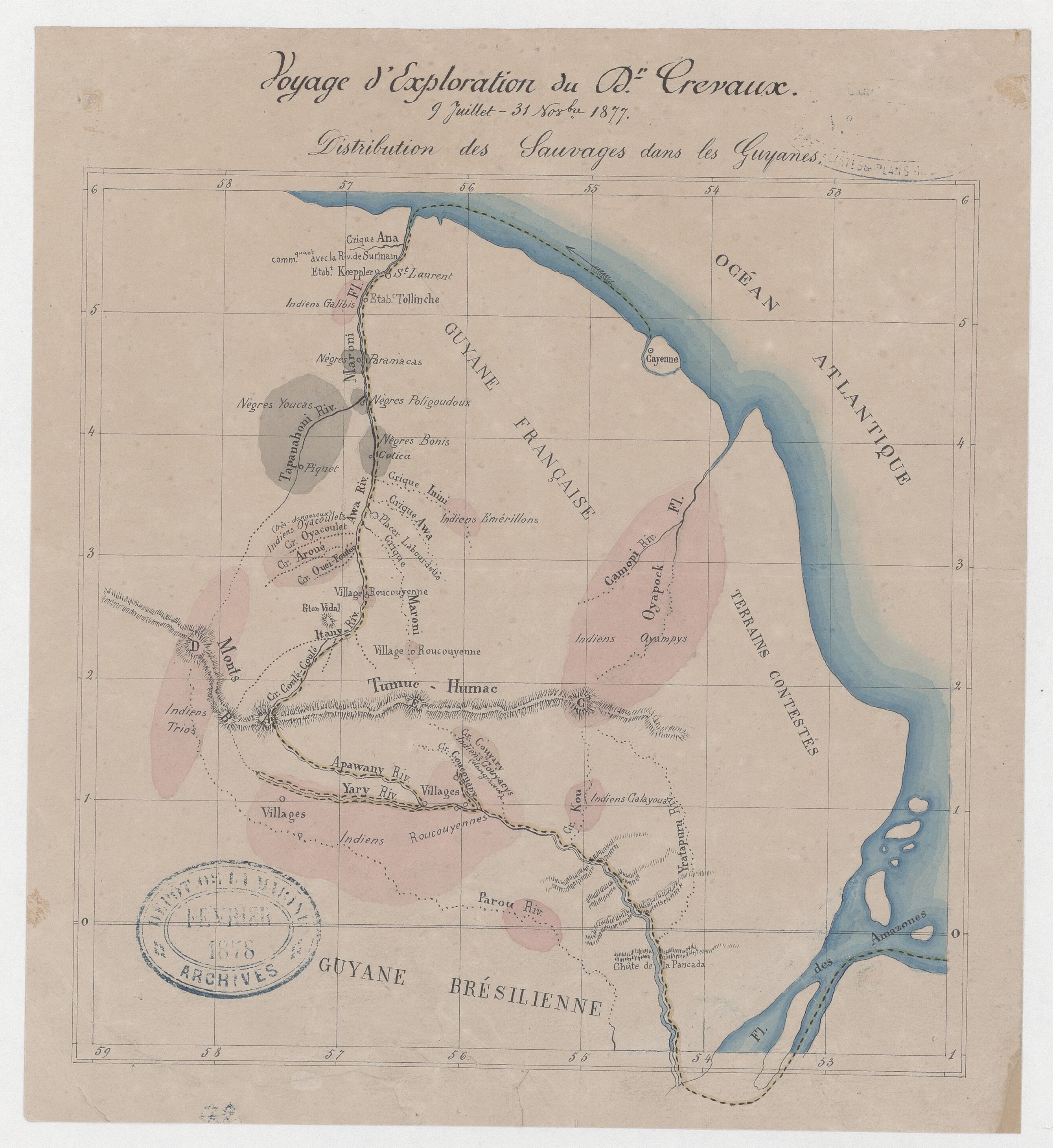Abstract
A new wave of interest in Guiana’s territory and inhabitants began in the second half of the nineteenth. At this time, two explorers visited the territory: Jules Crevaux (1847-1883) and Henri Coudreau (1859-1899). Both navigated the river Maroni, which marked the limits with Surinam. While Crevaux continued by the Jari, Coudreau went down through the Oyapock, by the current limits with Brazil.1 From these expeditions resulted in two books: Voyages dans l’Amérique du Sud (1883) and Chez nos Indians (1893), respectively*.* The map of the Crevaux depicts his journey from Cayenne through the Maroni River to the Amazon River’s opening and the Indigenous people he encountered during his expeditions.
Several explorations aimed to describe and understand the characteristics of the colonial world in the late nineteenth century. One strong motivation was to clearly define the boundaries between the colonial powers (in the case of French Guiana, with Suriname and with the Kingdom of Brazil).2 Other reasons stemmed from the ethnographic perspective of European colonialists.3 Material incentives also played a role, with the French Government turning its attention to Guiana following the discovery of gold deposits in the high Oyapock River and the Approuague River in 1855, areas traditionally inhabited by the Wayapi People.4
The map results from Crevaux’s first of three expeditions to South America between 1876 and 1883. In 1876, the Minister of Public Instruction commissioned him to explore the Maroni River. After falling sick of yellow fever in December 1876, he began the exploration of the river in July 1877 until April 1878, when he returned to France.5 One significant outcome of the exploration was a more concrete identification of Indigenous people, families, and groups who have been largely unknown since the first contact between Amerindians and Europeans.6 The map includes the location of eight Indigenous groups, some of which had already appeared in previous representations, such as the Emérillons, Galibis, Oyampys, Roucouyennes, and Trios. However, Crevaux also depicted some communities for the first time, like the Calayoua, the Couyarys, and the Oyacoulet. He noted that the last two were “very dangerous.” Instead of generalizing about the Indigenous people, Crevaux aimed to gain a deeper understanding of each community. Additionally, he wrote a book on the grammar of the Roucouyennes, Arrouague, and Piapoco languages. 7
This map also represents Afro descendant communities who lived autonomously on the margins of the Maroni River and its tributaries. Crevaux identified four groups: Bonis (Aluku), Paramacas (Paramaka), Poligoudoux, and Youcas (Djouka).8 It is important to note that the recognition of these communities went through several stages with the Dutch Government, and their protection by the French Government was crucial in demarcating the boundaries between French Guiana and Suriname.9 Crevaux passed away in April 1883 in Bolivia during his third journey to South America.
Map citation
Crevaux, Jules. Voyage d’exploration du Docteur Crevaux, 9 juillet - 31 novembre 1877: distribution des sauvages dans les Guyanes. Map. Paris, 1877. Bibliothèque National de France. – Gallica. Accessed August 12, 2024. https://gallica.bnf.fr/ark:/12148/btv1b531464634
François-Michel Le Tourneau and Anna Greissing, “Crevaux et Coudreau, arpenteurs des Tumuc Humac,” Le Jari. Géohistoire d’un grand fleuve amazonien (Rennes: Presses universitaires de Rennes, 2013), paragraph 27. DOI: https://doi.org/10.4000/books.pur.47984. ↩︎
Le Tourneau and Greissing, “Crevaux et Coudreau,” paragraph 5. ↩︎
A seminal discussion on the unequal relationship between anthropological view and non-Western communities appears in Diane Lewis, “Anthropology and Colonialism,” Current Anthropology, 14, 5 (1973): 581-602. ↩︎
Serge Mam-Lam-Fouck and Apollinaire Anakesa-Kululuka, Nouvelle histoire de la Guyane Française: des souverainetés amérindiennes aux mutations de la société (Matoury, Guyane: Ibis rouge, 2013), 90. ↩︎
Jules Crevaux, Voyage dans la Guyane et le bassin de l’Amazone, conférence faite à la Société de géographie de l’Est (Nancy: Impr. de Berger-Levrault, 1880), pp. 3-26. Bibliothèque National de France – Gallica. Accessed September 16, 2024. https://gallica.bnf.fr/ark:/12148/bpt6k5624539t ↩︎
Francis Dupuy, “Deux explorateurs dans l’intérieur de la Guyane à la fin du XIXe siècle : Jules Crevaux et Henri Coudreau” in Explorations et voyages scientifiques de l’Antiquité à nos jours, directed by Christiane Demeulenaere-Douyère (Paris: CTHS, 2008) 159-181. ↩︎
Jules Crevaux, P. Sagot, Lucien Adam, Grammaires et vocabulaires roucouyenne, arrouague, piapoco et d’autres langues de la région des Guyanes (Paris: Maisonneuve, 1882) ↩︎
About the current location of these groups, see: Richard Price and Sally Price, “The Arrivals of Marron in Guyane,” in Maroons in Guyane: Past, Present, Future (Athens: University of Georgia Press, 2022). ↩︎
Le Tourneau and Greissing, “Crevaux et Coudreau,” 5. Mam-Lam-Fouck and Anakesa-Kululuka, Nouvelle Histoire De La Guyane Française, 24. ↩︎
